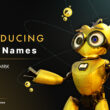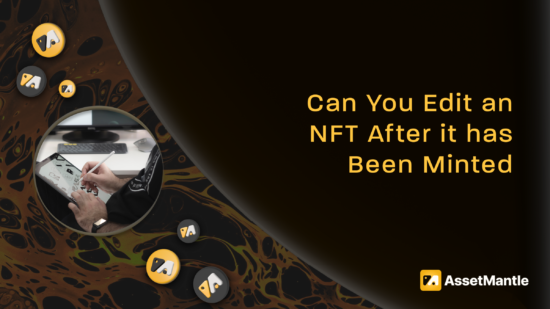Non-fungible tokens, or NFTs, are a fairly new development in the blockchain space. These tokens are unique and cannot be replicated, which makes them perfect for use in digital collectibles and other applications.
If you are an artist, creator, or anyone else who depends on digital tokens to represent your work, you may be wondering if it is possible to edit an NFT after it has been minted. Unfortunately, the answer is a partial no. Once a token has been issued, it is permanent and cannot be edited but its metadata can certainly be edited.
However, there are still a few things you can do to ensure that your NFTs represent your work in the best possible way. In this article, we will discuss some of these options.
You have formally created some NFTs, but maybe right after you minted it, you realized that the NFT does not meet you/your community standards, or maybe there are some copyright cases being made against your NFT. So, can you edit an NFT after it is minted?
NFTs are digital assets. Therefore, they contain metadata that identifies and sets them apart from other digital assets on a blockchain.
Why Would Anyone Want To Edit an NFT?
First and foremost, you need to know under what circumstances someone would need to edit an NFT.
Copyright Infringements
Copyright infringements are very frequent in the world of NFTs, especially with amateur NFT artists.
In such cases, people will have to figure out how to edit an NFT they made, and there isn’t really any way around it. If not resolved quickly, it could result in lawsuits and hefty fines.
Alternatively, the owner of the NFT could also burn it, but that would typically incur a heavy loss because they might have purchased it at a high price or they are the creators and they would miss out on royalties.
Changes to the Game
NFTs are common in decentralized games. Their properties very much influence how the game is perceived and also how easy or difficult it is for players to move to higher ranks in like MMORPG-like games.
Sometimes, it may happen that the NFT is no longer as effective in the game as it used to be. Hence, it has to be tweaked in a way that is still desired by the players.
On the other hand, there would be instances where the in-game NFT is much superior to other items and characters in the game. In such cases, the in-game asset needs to be nerfed so that the game is kept balanced.
A Few Other Possible Reasons
- To correct a mistake that was made when the NFT was created. For example, if someone accidentally creates a token with the wrong image or text, they might want to edit it to fix the error.
- To add new information to an NFT. For example, if someone creates a token representing their pet, they might want to add details about the pet (e.g., its name, age, breed, etc.).
- To modify an NFT for creative purposes. For example, if someone creates a token that represents a character in their favorite TV show, they might want to modify it over a period for the purposes of a storyline.
- The original creator of the NFT is no longer available to maintain it, and someone else needs to take over that responsibility.
- There may be some cases where third-party actors may want to modify NFTs for financial gain.
What Kind of Metadata Can Be Edited in an NFT?
You can certainly edit the metadata associated with the NFT.
There are two kinds of metadata:
- Mutable metadata
- Immutable metadata
As the name suggests, only mutable metadata can be edited or updated.
Some of the information that can be edited in an NFT’s metadata includes:
- The name of the NFT
- The description of the NFT
- The image associated with the NFT
- The URL associated with the NFT
- The owner of the NFT
- The category of the NFT
- Any other relevant information
It should be noted that not all of this information is required. However, the more information you have about an NFT, the better.
Further, what is considered mutable and immutable is at the discretion of the creator.
Some properties that are typically considered immutable are:
- Creator of the NFT
- Royalty percentage
- Token name
- Token ID
How Can You Edit an NFT After It’s Minted?
The Cosmos ecosystem offers a few options for editing NFTs after they have been minted.
The most common way to edit an NFT is by using functions that allow you to change the token’s properties such as name, description, etc.
Certain functions allow you to change the data associated with the token, such as the URI or content hash. You can also use these functions to add or remove data from the token.
For NFT metadata that is on-chain, users essentially need to perform a transaction that would update the metadata information on the ledger.
With MantlePlace, NFT creators do not have to go through a cumbersome process to an NFT. They can do so through a very intuitive and easy-to-use interface.
It’s important to note that you can only edit an NFT if you are the owner of the NFT or if you have been granted permission by the owner.
What Are the Implications of Editing an NFT?
It’s important to note that, while you can technically edit an NFT after it is minted, there are some implications to consider before doing so.
For one, editing an NFT could potentially change the token’s ID. This means that the token will no longer be recognizable as the same NFT it was before. However, for mutable metadata, this is not the case.
One risk of editing an NFT is that it could lead to confusion or fraud if NFTs are not edited carefully. Another risk is that editing an NFT could potentially change the token’s ID, which could make it difficult for others to recognize the NFT.
Additionally, any changes you make to an NFT will be visible on the blockchain for everyone to see. This could potentially cause confusion or even lead to fraud if someone is not careful.
Finally, it’s worth noting that not all NFT platforms allow for the editing of NFTs.
Is It Bad To Edit an NFT?
There is no easy answer to this question. It really depends on the situation and what you are hoping to accomplish by editing the NFT.
If you are simply trying to fix an error, then it is probably not a big deal. However, if you are trying to change the NFT in a way that could be confusing or misleading to others, then it might not be a good idea.
Ultimately, it is up to the NFT owner to decide whether or not to edit their NFT. They should weigh the pros and cons of doing so before making a decision.
For instance, editing an NFT’s metadata could tamper its rarity and cause it to dramatically slide down in value.
What Are Some Possible Use Cases for Editing NFTs?
There are a few potential use cases for editing NFTs.
One possible use case is for NFT creators to make changes to their NFTs after they have been minted. This could be helpful if they want to make changes to the NFT’s image, name, or description.
Another possible use case is for NFT platforms to allow users to edit their NFTs. This could be helpful if a user wants to change the URL associated with their NFT or add new data to their NFT.
Finally, it’s also possible that NFT platforms could use editing functions to help fight against fraud. For instance, if an NFT is stolen, the platform could allow the rightful owner to edit the NFT’s data in order to invalidate the stolen NFT.
Best Practices to Follow When Editing an NFT
If you are planning on editing an NFT, there are a few best practices to follow in order to avoid confusion or fraud.
First, it’s important to be clear about what changes you are making to the NFT. Any changes made to an NFT should be documented and tracked in order to ensure transparency and accountability.
Second, it’s also a good idea to keep a backup of the original NFT data. This will help you if you accidentally make a change that you don’t want or if you need to revert back to the original NFT for any reason.
Third, if you are using an NFT platform that allows for the editing of NFTs, make sure to check the platform’s terms of service before making any changes. This will help you avoid any potential problems down the road.
Finally, it’s always a good idea to exercise caution when editing an NFT. Make sure you understand the implications of your actions before making any changes.
Some Things to Consider While Editing an NFT
There is no right or wrong answer to this question, as the impact of editing an NFT will depend on the specific situation and how the edit is made. However, some things to consider include:
- Editing an NFT can change its meaning or interpretation, which could have unintended consequences.
- Editing an NFT can also create confusion or ambiguity, as different people might interpret the edited version differently.
- If an edit is made without proper consultation or agreement from all relevant parties, it could lead to conflict or disagreement.
- Any changes made to an NFT should be documented and tracked in order to ensure transparency and accountability.
It is up to you to decide if you want to edit an NFT you made, but just make sure you know all the complications and issues that could result from this.
Conclusion
In conclusion, editing an NFT can have a variety of different implications depending on the situation. Before making any changes to an NFT, be sure to weigh the pros and cons and consult with all relevant parties. Always exercise caution when making changes to an NFT, and be sure to document any changes that are made.

About AssetMantle
AssetMantle is a multi-tenant NFT marketplace framework that enables creators and collectors to securely mint, own, and trade digital assets on its fast-finality blockchain. The AssetMantle no-code toolset allows creators to create customized assets and marketplaces permissionless-ly . Likewise, collectors can own the assets minted across these marketplaces and compatible chains in a singular wallet with minimal gas and a lower carbon footprint. Built on the interNFT standard, AssetMantle implements an end-to-end stack of open-source modular tools that developers can modify to fit advanced use cases.
contribute to interchain NFT standards; currently being spearheaded by us & the interchain foundation: https://github.com/interNFT/nft-rfc/tree/main
Vision
Build an open-source, community-driven framework for inter-chain NFTs and metadata standardization by contributing to the ‘interNFT standard’.
Mission
Provide a platform that enables a diverse set of NFTs use cases that extend beyond arts and collectibles and can potentially change the representation of rights and ownership of real-world assets like real estate and other commodities.

AssetMantle is always on the lookout to connect with individuals or organizations who wish to take advantage of the opportunities present in the blockchain space and want to learn more about AssetMantle. If you wish to get in touch, please do not hesitate to reach out.
Follow AssetMantle’s social channels to stay up-to-date with the latest developments.
Twitter | Telegram | Discord | Instagram | LinkedIn | hello@assetmantle.one




